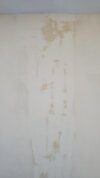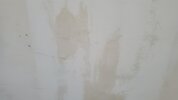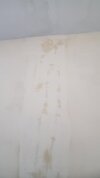- Joined
- 2 Jun 2023
- Messages
- 57
- Reaction score
- 7
- Country

Hi all
posting in case any of the experts here can help. Attached are photos of some damp patches upstairs in a bedroom - I painted the wallpaper about a year ago, the area affected is where a chimney breast used to be. Using one of those meters wiith electric prongs the readings are c. 10-15% from about 40cm either side of the lighter white rectangular patch from ceiling to a bit above the skirting board, and up to around 50% within the affected area [particularly but not only the darker patches within this rectangle. some higher reading in the lighter areas and either side up to 40cm]. Some small black marks now coming through [lines see pic ending 028 attached] as well.
No evidence of similar discolouration/damp patches either above in loft space or below in living room.




I have a roofer coming to take a look at the chimney and tiles above [when I bought the place a couple of years ago he replaced some cracked 40yr old concrete tiles and repaired flashing]. I'm aware my neighbour [other side of the party wall has had issues with damp]
My guess is that this is penetrating damp of some sort coming through the chimney stack or tiles above, but if that's the case I'm puzzled why there is no evidence of it in the attic above - except that it might be hidden by the [I think maybe newer] dry lining /dab and board in the attic room.
Any thoughts or ideas from others which much more expertise than myself very welcome
thanks in anticipation
posting in case any of the experts here can help. Attached are photos of some damp patches upstairs in a bedroom - I painted the wallpaper about a year ago, the area affected is where a chimney breast used to be. Using one of those meters wiith electric prongs the readings are c. 10-15% from about 40cm either side of the lighter white rectangular patch from ceiling to a bit above the skirting board, and up to around 50% within the affected area [particularly but not only the darker patches within this rectangle. some higher reading in the lighter areas and either side up to 40cm]. Some small black marks now coming through [lines see pic ending 028 attached] as well.
No evidence of similar discolouration/damp patches either above in loft space or below in living room.




I have a roofer coming to take a look at the chimney and tiles above [when I bought the place a couple of years ago he replaced some cracked 40yr old concrete tiles and repaired flashing]. I'm aware my neighbour [other side of the party wall has had issues with damp]
My guess is that this is penetrating damp of some sort coming through the chimney stack or tiles above, but if that's the case I'm puzzled why there is no evidence of it in the attic above - except that it might be hidden by the [I think maybe newer] dry lining /dab and board in the attic room.
Any thoughts or ideas from others which much more expertise than myself very welcome
thanks in anticipation
